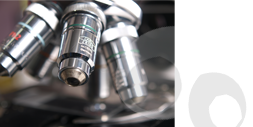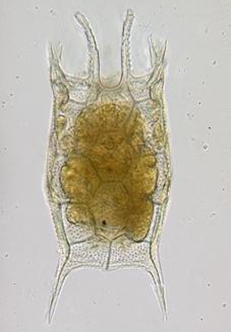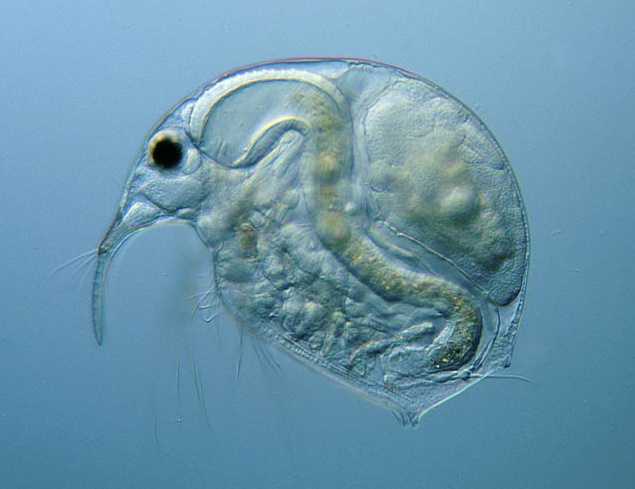

|
The Aquatic Microfauna
Why are freshwater Micro-invertebrates so important? The aquatic microfauna as a group link everything in a freshwater ecosystem together, and if this faunal group is missing for any reason then the system will quickly collapse. Therefore managers of wetlands, waterways, reservoirs, water and sewerage treatment plants, need an understanding of the environmental baseline conditions and ecology of these waters that influence these animals. Many species of the aquatic microfauna have life cycles measured in days (Rotifera) to weeks ( Cladocera, Copepoda, Ostracoda). Therefore the temporary nature of many waters within inland Australia favour the presence of the aquatic microfauna, rather than the aquatic macroinvertebrates with longer life cycles. It is these small animals that drive the ecology of inland waters. Micro-invertebrates are typically the first linkage in the aquatic food web, connecting the primary producers, ie plants and algae (that make their own food via photosynthesis), to the higher consumers within the web such as fish and birds. Micro-invertebrates play another really important role within aquatic food webs, by eating small pieces of dead and decomposing matter (detritus) and converting it into food for bacteria and other micro-organisms. Micro-invertebrates can also tell us a lot about the health of aquatic environments. Particular species are sensitive to certain pollutants and environmental stress. Whether a particular species is present or absent in a specific environment can tell us whether that environment is healthy or not. They also respond very quickly to changes in the environment and may therefore act as an early indicator of change. Other aquatic micro-invertebrates are extremely predacious and may attack larval fish. It is estimated that up to 90% of early stage, larval fish may fall victim to such predation (e.g. Carp). The Animals Rotifers Rotifers are probably the most abundant of all freshwater micro-invertebrates. Up until 15 years ago we knew next to nothing about Australian species of Rotifers. Today there are over 700 species know from Australian inland waters. Generally these minute animals (<0.2mm) are found in all inland water habitats at densities ranging up to 1000 individuals per litre. In some water bodies populations may exceed 12,000 individuals per litre- eg sewerage ponds. The vast majority of rotifers are solitary animals, free moving, either by swimming or crawling. The majority feed upon algae. They may reproduce very quickly and are usually present in temporary waters (puddles, temporary ponds, billabongs, lakes) very shortly after rain or filling of the water body. They hatch from eggs that are resistant to desiccation and may be found in the dry sediments of temporary water bodies. Having the ability to reproduce rapidly, rotifers may account for up to 50% or more of zooplankton production. This production is an important food resource for other rotifers, cyclopoid and calanoid copepods.
Keratella serrulata Ostracods Ostracods are a diverse group of animals. They are enclosed within a hinged double (bivalved) shell that is often coloured green, brown or yellow-orange. Ostracods are common in most types of aquatic systems within Australia, however our knowledge of this group of micro-invertebrates is still incomplete. Ostracods are benthic animals and are rarely found within the open waters of wetlands and rivers. Generally most ostracods are herbivorous and detritivores, consuming algae and organic detritus. Typically they are found in the littoral region of wetlands and rivers, amongst aquatic vegetation. Physical and chemical characteristics of the habitat are important factors in ostracod distribution and abundance. Generally they are found in waters with a high bicarbonate value. Bicarbonate is a primary constituent of the ostracod shell. Copepods The copepods are an extremely abundant group of micro-invertebrates, second only to the rotifers. There are three major types of copepods each with different life style requirements. Calanoids are primarily found in the open waters of ponds, wetlands and lakes. Harpacticoids are generally associated with the benthos in the littoral part of water bodies. Cyclopoids are also primarily benthic and littoral, found amongst aquatic vegetation. Development time from egg to adult is from 1-3 weeks, whilst the adult life span of a copepod is from one to 3 months. Freshwater copepods range in size from <0.5-2.0 mm in length and may be found in a wide variety of aquatic habitats, ranging from the benthos, littoral to open waters of lakes and rivers to the small volumes of water that may collect in plants. Swamps, wetlands and temporary waters may all have abundant copepod populations. Copepods are present, but less numerous in the flowing waters of rivers and creeks. Copepods feed on a wide variety of foods including algae, detritus, bacteria, rotifers, crustaceans, chironomids and even larval fish. For example international studies reported in peer reviewed scientific journals have shown cyclopoid predation on trout and carp fry of up to 90%. Therefore they occupy three of the four major trophic levels in the food web: detritivore, herbivore and carnivore. Most Cyclopoids and Calanoids are omnivorous and opportunistic, but tend to be selective where possible, where as Harpacticoids mainly feed upon algae and bacteria. Cladocerans Cladocerans are a diverse group occurring in all but the harshest freshwater habitats. They have a wide range of salinity tolerances, and are found from sea level to high altitude lakes. Cladocerans often live in temporary wetlands that dry out each year and have developed a number of adaptations to allow them to survive in these variable environments. They can complete their life cycles quickly, being mature within 7 –10 days of hatching from eggs. Their eggs are extremely tough and long lived and have adapted to surviving long dry periods by lying dormant in dry lake bed sediments waiting for the next flood event. In fact, Cladocerans eggs have successfully hatched from sediments that have been dry for approximately 300 years!
Bosmina meridionalis Which Bug Where? Whether or not a particular species occurs in a body of water depends upon on a combination of factors: 1) the probability of successfully colonizing the body of water; 2) chemical and physical requirements of the species; 3) food conditions within the water; 4) predators living in the water. There may be extreme conditions such as high salinity in a body of water, which may exclude many species, particularly Cladocerans. Some species are adapted to silt laden water, and are found in turbid or muddy water. Besides differing in habitat, planktonic and benthic micro-invertebrates differ in ecological relationships and evolution. Thus for example to imply that everything learnt about the Cladocerans Daphnia or Bosmina or the Cyclopoid Mesocyclops applies equally to all of the aquatic micro-invertebrates is misleading or incorrect. What can harm Aquatic Micro-invertebrates? Increasing salinity is a threat as many species are sensitive to salinity. The use of farm fertilizers has a profound affect on nearby waterways. One kilo of chemical fertilizers: Phosphorous or Nitrogen, will generate up to 1000 and 17 kilos of algal matter respectively. This has major implications for aquatic systems and their micro-invertebrate fauna. Pesticide contamination is known to kill aquatic organisms. The filtering habit of many micro-invertebrates means they are prone to accumulate pollutants. De-snagging of sections of our major River systems has wiped out many micro-invertebrate habitats. Land clearance and the resulting increased run off has had an impact on the ecology of river systems and wetlands, which in turn affect the aquatic micro-invertebrate fauna. Many wetlands now are permanently dry or permanently contain water. This has impacted upon and changed the aquatic micro-invertebrate fauna present. Decision makers have ignored the almost total lack of knowledge regarding this extremely important group of aquatic organisms. Water bodies are not uniform habitats with respect to concentrations of food, predators, dissolved oxygen concentrations, light intensity, temperature and water movements. Therefore micro-invertebrates are not evenly distributed in lakes, wetlands and river systems. Often there is considerable variability with respect to their vertical and horizontal distributions. These micro-invertebrates occupy many levels of the food web. Suspension feeding is common and involves the filtering of food (bacteria, protozoans, algae and small animals) from the water column using fine setae or hairs on their appendages. Other species may feed upon decomposing plant material (detritivores), other animals (predators) or all of the above (omnivores). Do you Know We know relatively little about the micro-invertebrates that inhabit our waterways in this country. New species are still being discovered and we have an awful lot to learn about their ecology within Australia.
|
 |
 |


